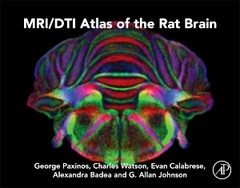MRI/DTI Atlas of the Rat Brain
Langue : Anglais
Auteurs : Paxinos George, Watson Charles, Calabrese Evan, Badea Alexandra, Johnson G. Allan

MRI/DTI Atlas of the Rat Brain offers two major enhancements when compared with earlier attempts to make MRI/DTI rat brain atlases. First, the spatial resolution at 25µm is considerably higher than previous data published. Secondly, the comprehensive set of MRI/DTI contrasts provided has enabled the authors to identify more than 80% of structures identified in The Rat Brain in Stereotaxic Coordinates.
IntroductionCoronal Plane (100 levels)Sagittal Plane (20 levels)Horizontal Plane (20 levels)
Neuroscientists, neuroanatomists, neuroimagers, the connectome community
Professor Paxinos is the author of almost 50 books on the structure of the brain of humans and experimental animals, including The Rat Brain in Stereotaxic Coordinates, now in its 7th Edition, which is ranked by Thomson ISI as one of the 50 most cited items in the Web of Science. Dr. Paxinos paved the way for future neuroscience research by being the first to produce a three-dimensional (stereotaxic) framework for placement of electrodes and injections in the brain of experimental animals, which is now used as an international standard. He was a member of the first International Consortium for Brain Mapping, a UCLA based consortium that received the top ranking and was funded by the NIMH led Human Brain Project. Dr. Paxinos has been honored with more than nine distinguished awards throughout his years of research, including: The Warner Brown Memorial Prize (University of California at Berkeley, 1968), The Walter Burfitt Prize (1992), The Award for Excellence in Publishing in Medical Science (Assoc Amer Publishers, 1999), The Ramaciotti Medal for Excellence in Biomedical Research (2001), The Alexander von Humbolt Foundation Prize (Germany 2004), and more
Charles Watson is a neuroscientist and public health physician. His qualifications included a medical degree (MBBS) and two research doctorates (MD and DSc). He is Professor Emeritus at Curtin University, and holds adjunct professorial research positions at the University of New South Wales, the University of Queensland, and the University of Western Australia.
He has published over 100 refereed journal articles and 40 book chapters, and has co-authored over 25 books on brain and spinal cord anatomy. The Paxinos Watson rat brain atlas has been cited over 80,000 times. His current research is focused on the comparative anatomy of the hippocampus and the claustrum.
He was awarded the degree of Doctor of Science by the University of Sydney in 2012 and received the Distinguished Achievement Award of the Austra
Charles Watson is a neuroscientist and public health physician. His qualifications included a medical degree (MBBS) and two research doctorates (MD and DSc). He is Professor Emeritus at Curtin University, and holds adjunct professorial research positions at the University of New South Wales, the University of Queensland, and the University of Western Australia.
He has published over 100 refereed journal articles and 40 book chapters, and has co-authored over 25 books on brain and spinal cord anatomy. The Paxinos Watson rat brain atlas has been cited over 80,000 times. His current research is focused on the comparative anatomy of the hippocampus and the claustrum.
He was awarded the degree of Doctor of Science by the University of Sydney in 2012 and received the Distinguished Achievement Award of the Austra
- Ninety-six coronal levels from the olfactory bulb to the pyramidal decussation are depicted
- Delineations primarily made on the basis of direct observations on the MRI contrasts
- Each of the 96 open book pages displays four items— top left, the directionally colored fractional anisotropy image derived from DTI (DTI - FAC); top right, the diffusion-weighted image (DWI); bottom left, the gradient recalled echo (GRE); and bottom right, a diagrammatic synthesis of the information derived from these three images plus two additional images, which are not displayed (ARDC and RD). This is repeated for 96 coronal levels, which makes the levels 250 µm apart
- The FAC images are shown in full color
- The orientation of sections corresponds to that in Paxinos and Watson’s The Rat Brain in Stereotaxic Coordinates, 7th Edition (2014)
- The images have been obtained from 3D isotropic population averages (number of rats=5). All abbreviations of structure names are identical to the Paxinos & Watson histologic atlas
Date de parution : 07-2015
Ouvrage de 224 p.
21.4x27.5 cm
Épuisé
Thèmes de MRI/DTI Atlas of the Rat Brain :
Mots-clés :
© 2024 LAVOISIER S.A.S.



